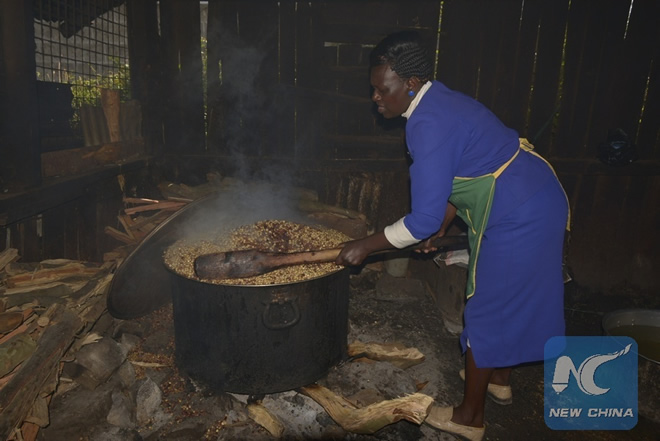
Tuesday, August 09, 2016
A Kenyan woman prepares a meal using a charcoal stove. (Xinhua/Nyalwash)
GARISSA, Kenya, Aug. 9 (Xinhua) -- For many residents in the semi-arid Garissa County in the northeast Kenya, Mathenge (Prosopis juliflora) is an invasive plant that needs to be cleared off.
But a group of young locals have sought to give it a new meaning by producing environmentally friendly charcoal.
They have come together under the identity of Green Charcoal, and are able to make the fuel safe for use in the indoor since it is smokeless.
"People see it as a menace but I consider it as an opportunity," said Mohamed Abass, the brainchild of the idea in an interview on Saturday.
At the moment, they are in a committed team of ten, making the charcoal from Garissa and transport some to the capital Nairobi for sale. They also have a huge market in the hospitality industry in Garissa.
The technology used in the production of the briquettes differs from the traditional one. Traditionally, one covers the lit wood with soil which leads to incomplete combustion of the biomass, in the end leading to emission of the toxic carbon monoxide gas when burnt.
In the modern method, the Green Charcoal uses a kiln to generate methane, which is then used to carbonize the Mathenge briquettes, and thus lowering emission of the toxic gases. They are able to produce three tonnes of the eco-friendly charcoal daily.
The green charcoal, which Abass said, serves as a substitute to the conventional charcoal burns for four straight hours and emits no smoke.
Five kilograms sells at 2 U.S. dollars at their current pricing, and can last for 14 days. On average one uses two kilograms of ordinary charcoal to cook one complete meal, while one can use five pieces of the briquettes to accomplish similar food preparation activity.
"It gives people value for their money and reduces air pollution," Abass said.
Indoor pollution from use of biomass fuel such firewood, kerosene and charcoal, is a major health concern in the developing countries, according to the World Health Organization (WHO).
Official data from the global health monitoring agency indicate that at least two million people in the developing nations succumb to complications from indoor air pollution.
Worse still is the fact that more than 80 percent of the pollution, especially in the rural areas, use the harmful fuels because of the high poverty levels further complicating intervention mechanisms.
WHO identifies lung cancer, tuberculosis, and respiratory infections as among the complications attributed to the indoor air pollution and whose effects are fatal, considering the poor are the most affected.
Green Charcoal's work matches with the Kenyan government's commitment to raise consumption of harmless fuels in the households.
In June, Cabinet Secretary for Treasury Henry Rotich announced removal of 16 percent Value Added Tax on the Liquefied Petroleum Gas (LPG), a move catapulting drop in gas cylinder prices and refilling rates.
He also reduced import levy on energy saving stoves by 60 percent.
He clarified this as the government's commitment to discourage use of the toxic fuels as well as protect the environment from extensive deforestation and degradation.
Abass, professionally an ICT specialist, said they are providing a sustainable solution to cutting down of the indigenous trees for charcoal burning.
He said Mathenge is pervasive plant whose presence in the northeastern county is unlikely to be terminated any time soon, thereby providing a ready supply of the raw materials to meet the demand.
Abass, who has no absolute background on energy or environment, said his venture into the green charcoal was driven by the need to commercialize the invasive plant and offer a better fuel option to households.
Mathenge, which flourishes in dry areas, is said to have originated from South and Central America and exists in six counties in Kenya found in the north-eastern, Rift valley and coastal regions.
Youth and women are among the beneficiaries of the venture in the county, which has been on the security watch over incidents of terror attacks from the Somalia-based militant group, Al-Shabaab.
Currently, Abass said they are directly working with five youth and three women groups, with each having an average membership of 15.
"They are part of our supply chain. They make money through selling the briquettes and that contributes to their livehoods," he said.